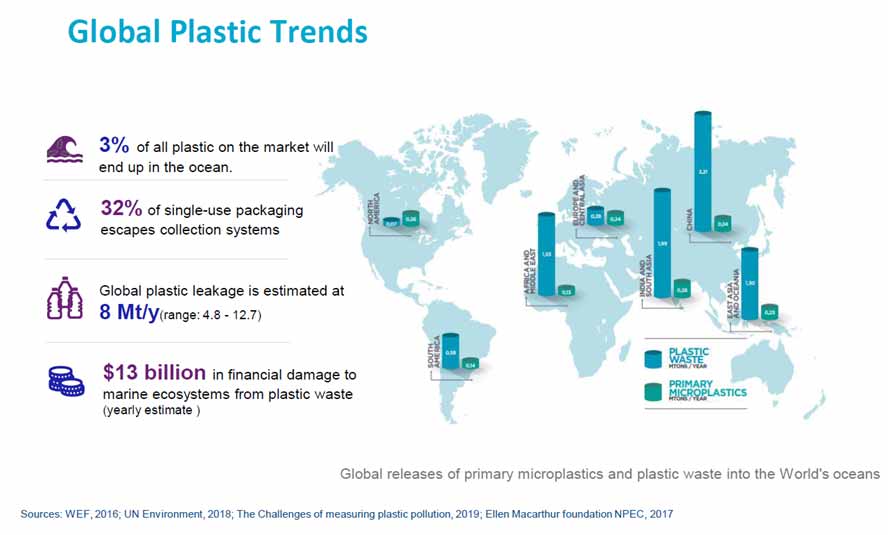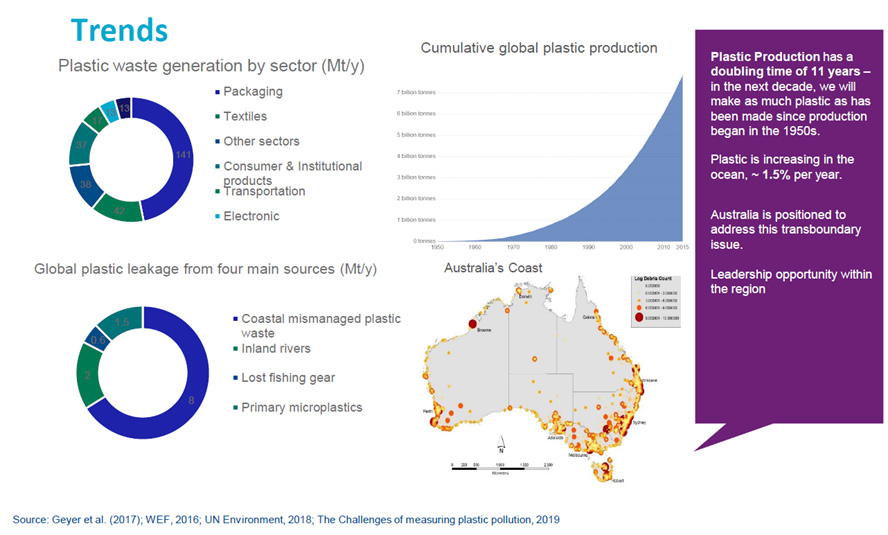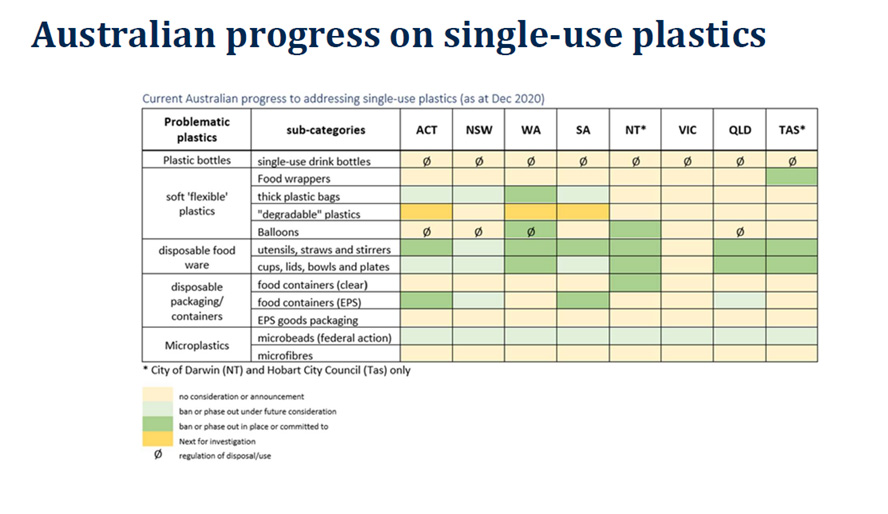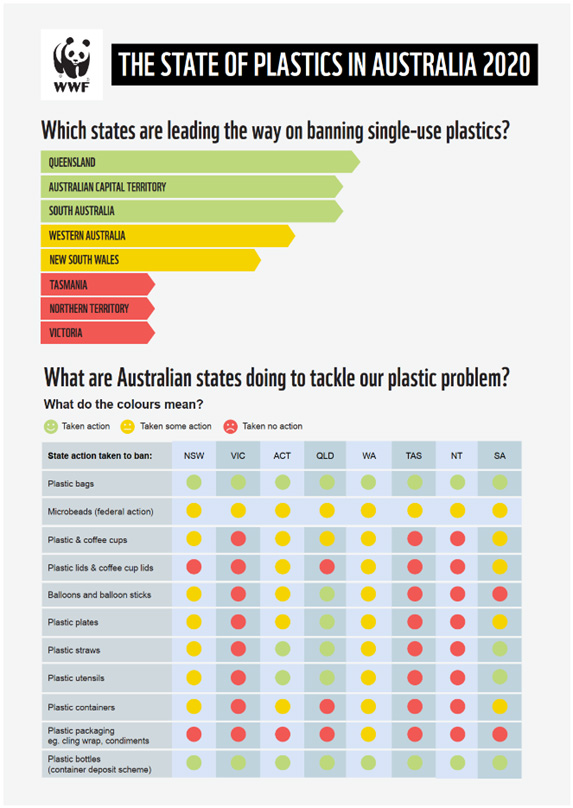Summary
Global plastic production has increased exponentially since the 1950s (Geyer et al. 2017). About three percent of global plastic production ends up in the oceans, and plastics are now ubiquitous in the world’s oceans, including marine sediments (Ritchie and Roser 2018). In 2010–11, Australia used 1,433,046 tonnes of plastic, of which only 20 per cent was ultimately recycled (Reisser et al. 2013). Ocean plastic can be broadly classified by size as microplastics (very small plastic fragments, including microfibres that separate from clothes during washing, and tiny fragments in cosmetics and shower products) or macroplastics (larger plastic pieces) (Sweet et al. 2019). Both types have direct and indirect negative impacts on marine organisms, often through pathways that are imperfectly understood (Reisser et al. 2013; Sweet et al. 2019; Alfaro-Núñez et al. 2021). Impacts on human beings (e.g. through seafood consumption) are less obvious, but may exist (SafeFish 2019a,b; Alfaro-Núñez et al. 2021). Australian governments at a range of levels have instigated policy responses, some of which already produced useful results (e.g. reduced use of microplastics in shower gels and similar products). However, numerous domestic sources of plastic waste have not received policy consideration. Products where different plastic types are combined in a single unit pose challenges for recycling (for example, milk bottle caps and retainer rings are a different material to the bottle, and must be separated, and many fishing nets also involve mixed polymers). Additionally, marine plastics are a transnational problem requiring global action for remediation (McIlgorm et al. 2011).
Understanding the ecological impacts of ocean plastics: macroplastics vs microplastics
The impacts of ocean plastics, both on marine animals and potentially for seafood consumers, can be best understood by separating plastics into two broad size categories; microplastics and macroplastics (Sweet et al. 2019). Microplastics are particles of up to 5 mm, while macroplastics are all others (Sweet et al. 2019; NOAA 2021). Distinguishing between these two categories is somewhat arbitrary, as microplastics are continually produced through the breakdown of macroplastics (e.g. through exposure to sunlight) (Sweet et al. 2019). Nonetheless, the distinction is useful in terms of understanding impacts.
Macroplastics harm marine organisms through ingestion or entanglement. Ingesting large pieces of plastic regularly kills seabirds, turtles, whales, and probably other taxa (Sweet et al. 2019). Less obviously, large pieces of plastic can also smother and/or physically damage small marine plants and animals, such as corals (Sweet et al. 2019). Through mechanisms that remain imperfectly understood, contact with macroplastics also makes corals more susceptible to disease.
Microplastics, as previously mentioned, can be produced by the breakdown of macroplastics (including release of synthetic fibres from clothes), or can be manufactured as very small particles (e.g. microbeads in cosmetics, synthetic sandblasting media) (Reisser et al. 2013; Sweet et al. 2019; Alfaro-Núñez et al. 2021; NOAA 2021). Microplastics are now found in all marine environments, including marine sediments. Microplastics can be ingested by filter-feeding or planktivorous animals, and propagate in food webs as these animals are in turn eaten by predators (for example, microplastics found in Southern Bluefin Tuna were likely ingested with prey) (Reisser et al. 2013). The ecological impacts of microplastic ingestion for marine organisms are incompletely understood, as research in this area has only begun fairly recently (but is increasing rapidly). The following effects have been reported:
- Following microplastic ingestion, organisms’ gastrointestinal tracts may be blocked or filled by plastic particles, preventing food consumption and/or acting as a physical obstruction.
- Leaching of toxic chemicals from ingested microplastics, causing damage to reproductive, digestive, and endocrine systems in marine organisms.
- Attraction and accumulation (adsorption) of other toxins onto microplastics, magnifying their harmful effects when ingested by marine animals—through adsorption, microplastics become “vehicles” for transporting other toxins into the bodies of marine animals (Reisser et al. 2013; SafeFish 2019a; Sweet et al. 2019; Alfaro-Núñez et al. 2021; NOAA 2021).
Large accumulations of both micro- and macroplastics in oceanic convergence zones or gyres (“marine garbage dumps”) (Reisser et al. 2013) have caused considerable recent commentary and drawn public attention, including through the Netflix program “Seaspiracy”. Ongoing media interest in this and other aspects of marine plastics will likely ensure growing public focus on the issue.
Risks posed by microplastics for seafood consumers
The risks posed by microplastics to seafood consumers in Australia and New Zealand have been summarised in factsheets produced by the SafeFish program (primarily funded by FRDC). Briefly, assessing the risks to seafood consumers requires considering (i) the likelihood that microplastics will be ingested by people while eating seafood, and (ii) the potential harms that could result following ingestion. The risk that Australian and New Zealand seafood consumers would ingest microplastics while eating seafood is generally low, as for most seafood species the gastro-intestinal tract is removed before consumption. For seafood that is eaten whole (e.g. shellfish), the risk is slightly higher. Of microplastics that are ingested, 90 per cent or more are likely to be excreted with faeces. However, it is important to note that further research is required to understand potential human health impacts from the microplastics themselves and from any adsorbed toxins.
Relevant Research
Marine plastic research globally is a rapidly growing field with numerous outputs. Many areas of research are being pursued in Australian fisheries R&D, including some enabled through investment from the Fisheries Research and Development Corporation, to improve knowledge and inform action, including:
- Removal and future avoidance of lost fishing gear (“ghost gear”)
- Understanding plastic use across fishing and aquaculture
- Minimising plastic use in specific sectors and fisheries
- Reducing use of polystyrene throughout the supply chain
- Measures to ensure that fishing vessels can reduce or eliminate the plastic they take to sea (e.g. finding alternatives to plastic tie-down straps, bait bags etc).
- Understanding prevalence of microplastics in seafood
- Documenting the extent, distribution in different habitat types, quantities, compositions, and sources of marine plastics in Australia (e.g. better understanding the problem’s dimensions)
- Moving towards a circular economy (aiming to eventually eliminate single-use plastics, and reducing, recycling, and regenerating other types).
- Understanding ecological and food safety impacts.
- AgriFutures media release 8 May 2023: Real and tangible waste management actions that can be employed in agriculture
- AgriFutures report: Options for improved waste management
Graphical summaries
The following pages provide graphical summaries illustrating the dimensions of the ocean plastics issue, and summarising Australian policy responses.




References
Alfaro-Núñez, A., Astorga, D., Cáceres-Farías, L., Bastidas, L., Villegas, C.S., Macay, K. & Christensen, J.H. (2021). Microplastic pollution in seawater and marine organisms across the tropical Eastern Pacific and Galápagos. Scientific Reports 11, https://www.nature.com/articles/s41598-021-85939-3.
Geyer, R., Jambeck, J.R. & Law, K.L. (2017). Production, use, and fate of all plastics ever made. Science Advances 3, DOI: 10.1126/sciadv.1700782
McIlgorm, A., Campbell, H.F. & Rule, M.J. (2011). The economic cost and control of marine debris damage in the Asia-Pacific region. Ocean & Coastal Management 54, 643–651. doi:10.1016/j.ocecoaman.2011.05.007
NOAA (2021). What are microplastics? https://oceanservice.noaa.gov/facts/microplastics.html accessed 7/07/2021
Reisser, J., Shaw, J., Wilcox, C., Hardesty, B.D., Proietti, M., Thums, M. & Pattiaratchi, C. (2013). Marine plastic pollution in waters around Australia: characteristics, concentrations, and pathways. PLoS One 8, e80466. https://doi.org/10.1371/journal.pone.0080466
Ritchie, H. & Roser, M. (2018). Plastic Pollution. Published online at OurWorldInData.org. Retrieved from: 'https://ourworldindata.org/plastic-pollution' [Online Resource], on 7/07/2021.
SafeFish (2019a). SafeFish Overview: Micro Plastics in Seafood. SafeFish fact sheet accessed at https://www.safefish.com.au/reports/food-safety-fact-sheets/microplastics-in-seafood on 7/07/2021.
SafeFish (2019b). Microplastic research in Australia and New Zealand August 2019. SafeFish fast sheet accessed at https://www.safefish.com.au/reports/food-safety-fact-sheets/microplastics-research-australia-new-zealand on 7/07/2021.
Sweet, M., Stelfox, M. & Lamb, J. (2019). Plastics and shallow water coral reefs. Synthesis of the science for policy makers. United Nations Environment Program. https://wedocs.unep.org/bitstream/handle/20.500.11822/27646/plastic_corals.pdf?sequence=1&isAllowed=y






